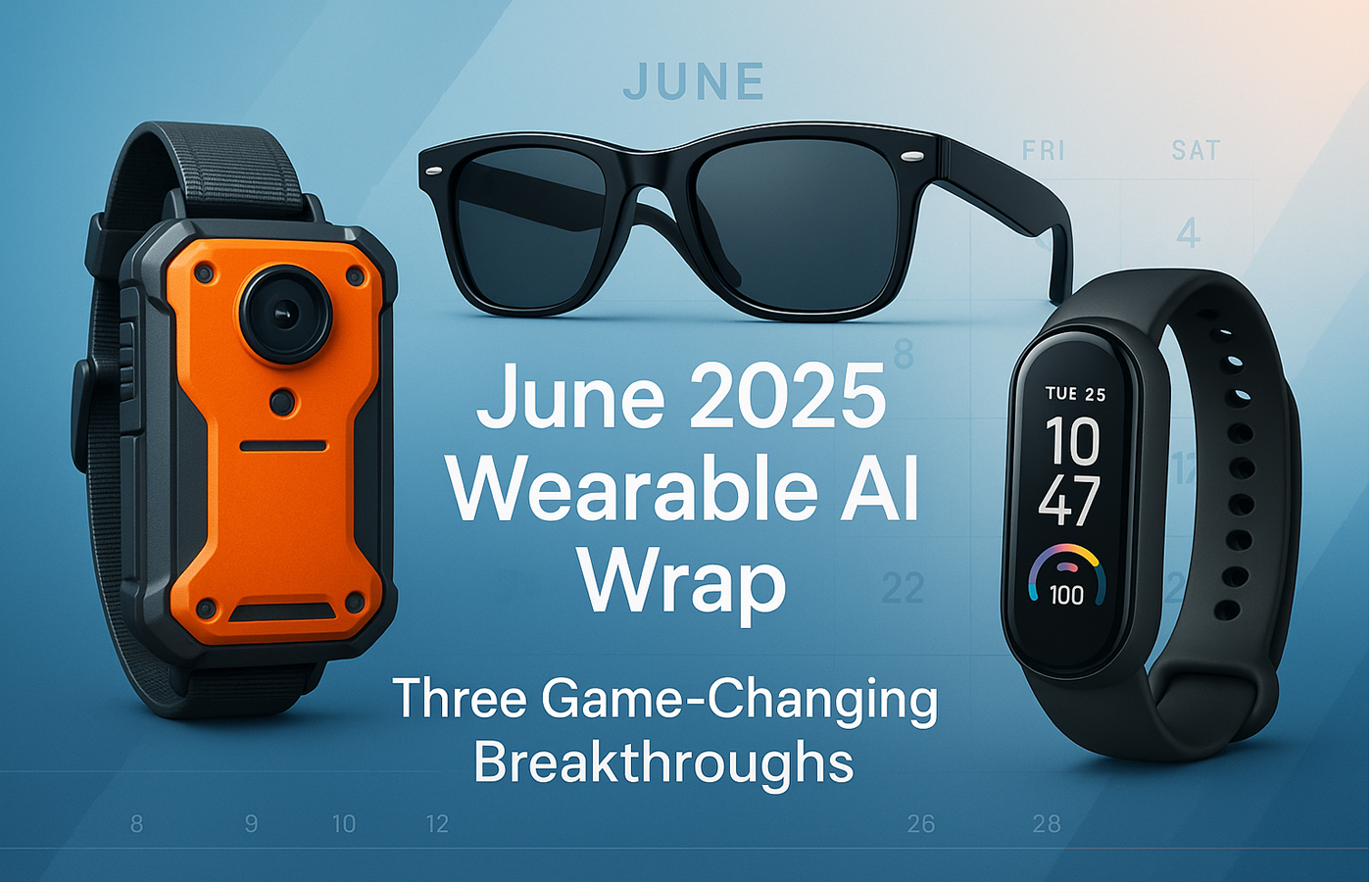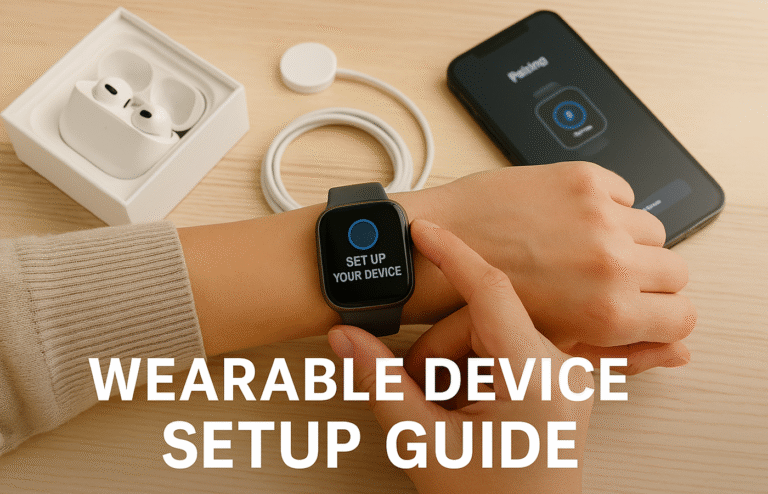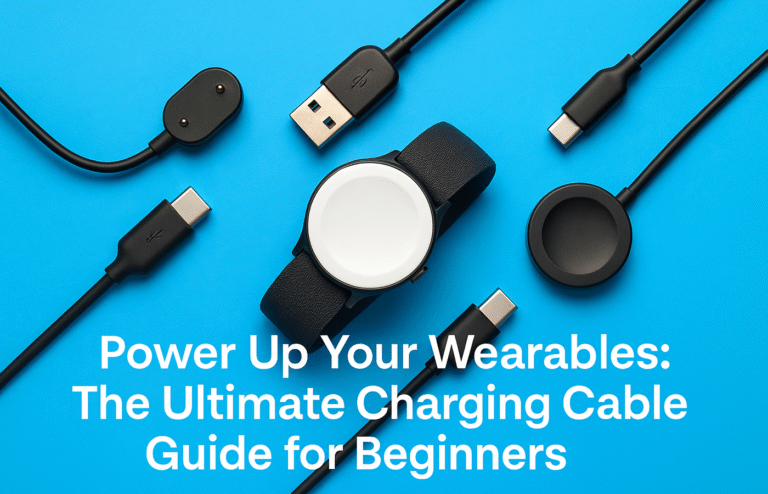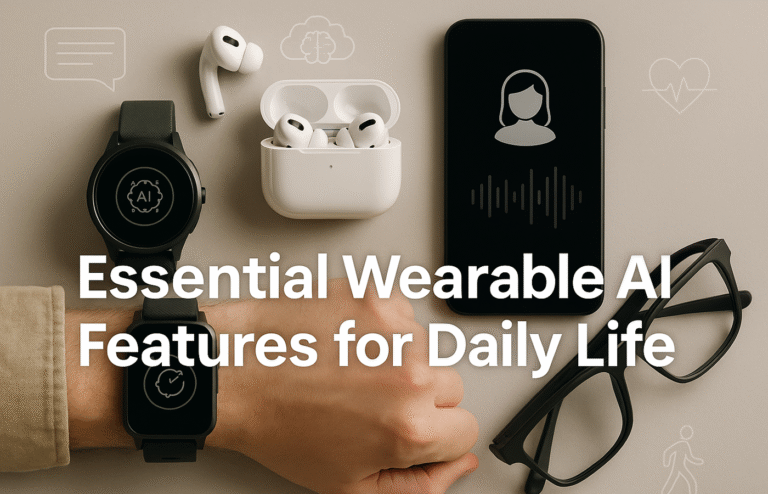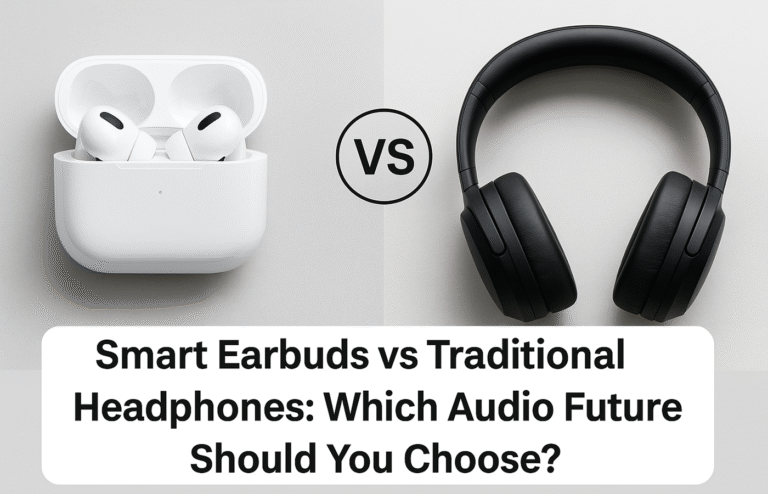June 2025 Wearable AI Wrap: Three Game-Changing Breakthroughs
June 2025 delivered revolutionary wearable AI innovations across enterprise, consumer, and fitness sectors, demonstrating technology’s evolution from experimental gadgets to essential tools.
Samsara’s Industrial Wearable:
● Announced at Beyond conference on 24th June
● Over one-year battery life through innovative connectivity
● Fall detection and one-click emergency services
● Targets transport, logistics, construction, and field services
Xiaomi AI Smart Glasses:
● Launched 30th June, challenging Meta’s market dominance
● 12MP camera, real-time translation, “pay-by-glance” payments
● Double the battery life of competitors
● Pricing from $410-$615 AUD
Xiaomi Smart Band 10:
● 1.72-inch AMOLED display with 1,500 nits brightness
● AI-driven health analytics and enhanced sleep tracking
● 21-day battery life, priced $75-$125 AUD
● Professional-grade insights at consumer pricing
Implications: These developments mark pivotal shift towards mainstream AI wearable adoption, workplace safety enhancement, and accessible health monitoring for Australian consumers.
June 2025 Wearable AI Wrap: Three Game-Changing Breakthroughs
June 2025 delivered a powerful trifecta of wearable AI innovations that demonstrate the technology’s rapid evolution from experimental gadgets to essential workplace and lifestyle tools. From breakthrough industrial safety solutions to cutting-edge consumer wearables and revolutionary health monitoring platforms, this month showcased how AI is transforming wearable technology across multiple sectors.
1. Samsara’s Revolutionary Industrial Wearable Sets New Safety Standards
The most significant enterprise development of June 2025 was Samsara’s announcement of the Samsara Wearable at their Beyond conference in San Diego on 24th June. This industrial-grade safety device represents a quantum leap forward in worker protection technology, addressing the critical safety needs of frontline workers across transport, logistics, construction, and field services.
What makes the Samsara Wearable particularly groundbreaking is its unprecedented battery life and innovative connectivity approach. Unlike traditional wearable devices that rely on cellular networks and drain batteries within 24 hours, the Samsara Wearable leverages the company’s existing network of millions of connected devices to achieve over one year of battery life. This breakthrough eliminates the primary barrier to continuous worker safety monitoring in demanding industrial environments.
The device’s safety features address real-world workplace hazards with remarkable sophistication. Fall detection technology can automatically detect incidents such as slips on icy surfaces, falls from heights like scaffolding or cranes, providing immediate alerts to management teams. The one-click protection feature enables workers to instantly connect to emergency services, who can immediately pinpoint precise location and access real-time audio recordings of the situation.
Moreover, the integration with proactive threat management demonstrates how AI can prevent accidents before they occur. Fleet managers can issue weather alerts for severe conditions or wildfires directly to workers’ devices, whilst automated check-ins monitor worker wellness if they’ve been idle too long or become unresponsive.
For Australian businesses, particularly those in mining, construction, and logistics sectors, this technology could significantly reduce workplace incident rates and associated costs. The device’s rugged design and year-long battery life make it particularly suitable for remote Australian work environments where traditional communication infrastructure may be limited.
Whilst pricing hasn’t been officially announced for the Australian market, industry estimates suggest the device will be competitively positioned against traditional safety equipment when considering the comprehensive monitoring capabilities and potential insurance premium reductions.
2. Xiaomi’s AI Smart Glasses Challenge Meta’s Market Dominance
June 2025 witnessed Xiaomi’s bold entry into the competitive AI smart glasses market with the announcement of their AI-powered smart glasses at the “Human x Car x Home” ecosystem event in Beijing on 30th June. These glasses represent a direct challenge to Meta’s Ray-Ban smart glasses, offering superior battery life and competitive pricing that could reshape the consumer AR market.
Powered by the Snapdragon AR1 Gen 1 platform and paired with a BES2700 series Bluetooth chip, Xiaomi’s smart glasses deliver a compelling combination of augmented reality capabilities and practical functionality. The integration of a 12MP camera enables hands-free photo capture and point-of-view video recording, whilst real-time translation capabilities break down language barriers for international travellers and business professionals.
The standout feature that differentiates Xiaomi’s offering is the innovative “pay-by-glance” functionality via Alipay integration. This represents a significant advancement in contactless payment technology, enabling users to complete transactions simply by looking at compatible payment terminals. For Australian consumers, this suggests future integration with local payment systems could revolutionise retail interactions.
Battery performance represents a crucial advantage over competitors. Whilst Meta’s Ray-Ban smart glasses require daily charging, Xiaomi’s glasses offer twice the battery life, addressing one of the primary user complaints about existing smart eyewear. This improvement could be the difference between occasional use and true daily adoption.
The pricing strategy demonstrates Xiaomi’s commitment to mainstream adoption. With an RRP starting at approximately $410 AUD (converted from $280 USD) for the basic model and extending to $615 AUD ($420 USD) for premium tint-shifting versions, these glasses are positioned competitively against Meta’s offerings while providing enhanced functionality.
The Xiaomi AI Smart Glasses are not officially available for purchase in Australia and imported versions would have severely limited functionality since the core AI voice assistant only supports Chinese language. Australian consumers should however anticipate this technology becoming available through Xiaomi’s established retail channels by late 2025 or early 2026, pending local regulatory approvals for the payment integration features.
3. Next-Generation Fitness Technology Arrives with Xiaomi Smart Band 10
The third major breakthrough came with Xiaomi’s launch of the Smart Band 10 on 30th June 2025, representing a significant evolution in affordable AI-powered fitness tracking. This device demonstrates how artificial intelligence is becoming accessible to mainstream consumers through incremental but meaningful improvements in health monitoring capabilities.
The Smart Band 10’s most notable advancement is its 1.72-inch AMOLED display with 60Hz refresh rate and 1,500 nits peak brightness, representing a 25% increase in brightness over its predecessor. This improvement ensures excellent readability in bright Australian outdoor conditions, crucial for fitness enthusiasts and outdoor workers.
Behind the improved hardware lies sophisticated AI-driven health analytics powered by upgraded high-precision sensors and enhanced algorithms. The device provides exceptionally accurate health and fitness tracking, delivering reliable data for comprehensive wellness monitoring. Whether cycling, running, or swimming, the Smart Band accurately tracks key metrics like VO₂ max, training load, and recovery time, providing actionable insights to optimise workout performance.
The integration of advanced sleep tracking represents a significant leap forward in consumer health monitoring. The device now offers enhanced sleep management with personalised guidance, helping users understand and improve their sleep patterns through AI-driven recommendations. This capability transforms the device from a simple activity tracker into a comprehensive wellness coach.
Australian pricing reflects Xiaomi’s commitment to accessibility, with the Smart Band 10 available through major retailers at an RRP of approximately $75-$125 AUD, depending on the variant and accessories selected. This pricing strategy ensures advanced AI health monitoring remains accessible to a broad consumer base whilst delivering professional-grade insights.
The device’s 21-day battery life ensures continuous monitoring without the inconvenience of frequent charging, crucial for Australian users who may spend extended periods outdoors or away from charging facilities.
The Broader Implications for Australian Consumers
These three developments collectively illustrate how June 2025 marked a pivotal moment in wearable AI evolution across different market segments. Samsara’s industrial wearable demonstrates that AI safety monitoring is becoming essential for workplace protection, particularly in Australia’s resource-intensive industries. The technology’s potential to reduce workplace incidents and associated costs makes it attractive for businesses whilst improving worker safety and job satisfaction.
Xiaomi’s smart glasses signal the beginning of mainstream AI eyewear adoption. The combination of practical functionality, competitive pricing, and enhanced battery life suggests that 2025-2026 will see broader consumer acceptance of AI-powered visual interfaces. Australian consumers should prepare for a new category of everyday computing devices that seamlessly integrate information overlay with real-world activities.
The Smart Band 10’s success demonstrates that AI-powered health monitoring is becoming increasingly sophisticated whilst remaining affordable. This trend suggests that advanced health analytics, previously available only in expensive medical devices, are becoming accessible to everyday consumers.
Furthermore, these developments highlight the importance of AI processing capabilities in wearable devices. Rather than relying solely on smartphone connectivity, modern wearables increasingly incorporate on-device AI processing for real-time analysis and immediate feedback. This shift towards edge computing in wearables ensures better privacy protection and reduced dependency on network connectivity.
Looking ahead, June 2025’s innovations set the foundation for a more connected, safer, and health-conscious future where wearable AI devices serve as essential tools for work, communication, and personal wellness. Australian consumers and businesses should anticipate continued innovation in this space, with particular opportunities in industrial safety, augmented reality applications, and preventive healthcare monitoring.

